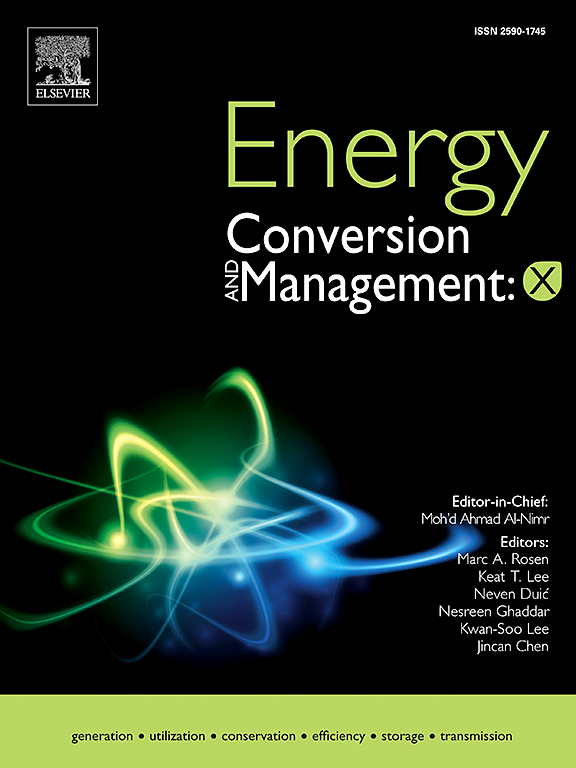用于可持续太阳能发电的超高温地热电池
IF 10.9
1区 工程技术
Q1 ENERGY & FUELS
引用次数: 0
摘要
本研究提出了一种新型地热电池系统,该系统将聚光太阳能热发电(CSP)与超高温地下热能储存(UHT-UTES)相结合,以解决当前高温储能技术的局限性。通过利用CSP废热,这种方法旨在超越现有CSP和UTES系统的温度限制,增强地热发电,并实现可扩展的、长期的能源存储解决方案。在此基础上,建立了一种有效的一维分析模型,用于评价高温-高温潜热系统内的传热动力学和热锋传播。该分析模型与裂缝性和多孔性储层的数值结果进行了对比验证,证实了其在模拟地下热行为方面的可靠性。该研究集中在三个关键目标上:(1)基于可用的CSP废热确定最佳地热电池尺寸;(2)量化剩余废热在底部循环中的效率增益;(3)通过耗尽阶段评估长期性能。结果表明,该综合系统可以在30年的时间里(在油藏中互不干扰的双井数量范围内)维持超过n × 114 MW的额外净热电输出。CSP退役后,该系统允许30年的逐渐枯竭,强调其长期储能潜力和可持续性。与传统的地热-有机朗肯循环(ORC)系统相比,该系统的平均热能增益为70%。本研究以印度尼西亚一个正在运行的地热场址为参考案例,为今后研究CSP一体化的技术、经济和环境影响奠定了基础。本文章由计算机程序翻译,如有差异,请以英文原文为准。
An ultra-high-temperature geothermal battery for sustainable solar power
This study proposes a novel geothermal battery system that combines concentrated solar thermal power (CSP) with ultra-high temperature underground thermal energy storage (UHT-UTES) to address limitations in current high-temperature energy storage technologies. By utilising CSP waste heat, this approach aims to surpass the temperature constraints of existing CSP and UTES systems, enhancing geothermal power generation and enabling a scalable, long-duration energy storage solution. A validated one-dimensional analytical model is developed to evaluate heat transfer dynamics and thermal front propagation within the UHT-UTES system. The analytical model is validated against numerical results for both fractured and porous reservoirs, confirming its reliability for simulating subsurface thermal behaviour. The study focuses on three key objectives: (1) determining the optimal geothermal battery size based on available CSP waste heat, (2) quantifying efficiency gains in the bottoming cycle from surplus waste heat, and (3) assessing long-term performance through a depletion phase. Results indicate that the integrated system can sustain an additional net thermal power output exceeding n 114 MW for 30 years (withn the number of non-interfering well doublets in the reservoir). Post decomissioning of the CSP the system allows 30 years of gradual depletion, underscoring its long-term energy storage potential and sustainability. Compared to conventional geothermal-Organic Rankine Cycle (ORC) systems, the proposed configuration delivers an average thermal energy gain of 70%. This research establishes a foundation for future studies on the technical, economic, and environmental implications of CSP integration, with a reference case based on an operational geothermal site in Indonesia.
求助全文
通过发布文献求助,成功后即可免费获取论文全文。
去求助
来源期刊

Energy Conversion and Management
工程技术-力学
CiteScore
19.00
自引率
11.50%
发文量
1304
审稿时长
17 days
期刊介绍:
The journal Energy Conversion and Management provides a forum for publishing original contributions and comprehensive technical review articles of interdisciplinary and original research on all important energy topics.
The topics considered include energy generation, utilization, conversion, storage, transmission, conservation, management and sustainability. These topics typically involve various types of energy such as mechanical, thermal, nuclear, chemical, electromagnetic, magnetic and electric. These energy types cover all known energy resources, including renewable resources (e.g., solar, bio, hydro, wind, geothermal and ocean energy), fossil fuels and nuclear resources.
 求助内容:
求助内容: 应助结果提醒方式:
应助结果提醒方式:


